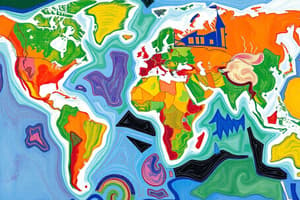Podcast
Questions and Answers
What type of location describes where something is in relation to other places?
What type of location describes where something is in relation to other places?
- Geographical location
- Relative location (correct)
- Absolute location
- Specific location
Which of the following is NOT a characteristic of place in geography?
Which of the following is NOT a characteristic of place in geography?
- Landforms
- Cultural practices
- Climate
- Historical events (correct)
In the context of human-environment interaction, which of the following is an example of a positive effect?
In the context of human-environment interaction, which of the following is an example of a positive effect?
- Deforestation
- Urbanization
- Pollution
- Agriculture (correct)
What is a formal region defined by?
What is a formal region defined by?
Which factor is least likely to influence climate in a particular area?
Which factor is least likely to influence climate in a particular area?
What term describes the interconnected communities of living organisms and their physical environment?
What term describes the interconnected communities of living organisms and their physical environment?
Which of the following is an example of a natural hazard?
Which of the following is an example of a natural hazard?
The study of human populations includes which of the following aspects?
The study of human populations includes which of the following aspects?
What is one primary reason for demographic urbanization?
What is one primary reason for demographic urbanization?
Which type of economic activity involves the extraction of raw materials?
Which type of economic activity involves the extraction of raw materials?
What is a common consequence of rapid urbanization?
What is a common consequence of rapid urbanization?
Which factor most significantly influences the location of settlements?
Which factor most significantly influences the location of settlements?
Sustainable development aims to balance which of the following?
Sustainable development aims to balance which of the following?
Flashcards
What is Geography?
What is Geography?
The study of the Earth's surface, its features, and the processes that shape them. It examines how people interact with their environment, including location, place, human-environment interactions, movement, and regions.
Location
Location
Describes where something is found. Absolute location uses coordinates (latitude and longitude), while relative location describes where something is in relation to other places.
Place
Place
Describes the unique characteristics of a location. It includes physical features (landforms, climate) and human characteristics (culture, population).
Human-Environment Interaction
Human-Environment Interaction
Signup and view all the flashcards
Movement
Movement
Signup and view all the flashcards
Regions
Regions
Signup and view all the flashcards
Population
Population
Signup and view all the flashcards
Landforms
Landforms
Signup and view all the flashcards
Economic Activities
Economic Activities
Signup and view all the flashcards
Urbanisation
Urbanisation
Signup and view all the flashcards
Culture
Culture
Signup and view all the flashcards
Resource Management
Resource Management
Signup and view all the flashcards
Sustainable Development
Sustainable Development
Signup and view all the flashcards
Study Notes
Introduction to Geography
- Geography studies the Earth's surface, its features, and the processes shaping them.
- It combines physical and human aspects, examining human-environment interactions.
- Key concepts include location, place, human-environment interaction, movement, and regions.
Key Geographical Concepts
- Location: Describing where something is.
- Absolute location uses coordinates (latitude and longitude).
- Relative location describes position in relation to other places.
- Place: Unique characteristics of a location.
- Physical features (landforms, climate).
- Human characteristics (culture, population).
- Human-Environment Interaction: How humans affect and are affected by their environment.
- Examples include deforestation, agriculture, urbanization, and pollution.
- Movement: How people, goods, and ideas move between places.
- Includes transportation systems, migration patterns, and communication networks.
- Regions: Areas with shared characteristics.
- Formal regions are defined by specific criteria (e.g., states).
- Functional regions are defined by connections (e.g., a city and its suburbs).
- Perceptual regions are defined by people's feelings or ideas (e.g., "the South").
Physical Geography
- Landforms: Earth's surface shapes and features.
- Mountains, plains, plateaus, valleys, and coastal features (beaches, cliffs).
- Formation processes include tectonic plates and erosion.
- Climate: Long-term weather patterns.
- Factors like latitude, altitude, and prevailing winds influence climate.
- Different climate zones (tropical, temperate, polar).
- Water Systems: Rivers, lakes, oceans, and groundwater.
- Hydrologic cycle (evaporation, condensation, precipitation).
- Water's importance for ecosystems and human activities.
- Natural Hazards: Threats to people and property.
- Earthquakes, volcanoes, floods, droughts, and storms.
- Understanding causes, effects, and preparedness.
- Ecosystems: Interconnected living organisms and their environment.
- Various ecosystems (forests, grasslands, deserts, wetlands).
- Importance of biodiversity and conservation efforts.
Human Geography
- Population: Study of human populations.
- Distribution, density, growth rate, and migration patterns.
- Factors influencing population (birth rate, death rate, economic opportunities).
- Settlement Patterns: How and where people live.
- Rural and urban areas; their characteristics and contrasts.
- Factors influencing settlement locations (resources, transport, climate).
- Economic Activities: Ways people earn a living.
- Primary (agriculture, mining), secondary (manufacturing), tertiary (services), quaternary (knowledge-based).
- Global trade and interdependence.
- Culture: Customs, beliefs, and traditions.
- Cultural diversity and its impact on societies.
- Urbanisation: Increasing proportion of people living in cities.
- Causes of urbanisation, associated problems, and solutions.
Geographical Skills
- Map Reading: Understanding map scales, symbols, and directions.
- Interpreting different map types (topographic, thematic).
- Data Analysis: Collecting and interpreting data.
- Analyzing population figures and climate records.
- Fieldwork: Observing and recording geographical features.
Geographical Applications
- Sustainable Development: Meeting present needs without compromising future generations.
- Environmental Issues: Addressing pollution, climate change, and resource management.
- Regional Planning: Developing strategies for land and resource use.
- Resource Management: Responsible utilization of natural resources.
Case Studies (Examples)
- Amazon Rainforest: Deforestation, biodiversity, Indigenous communities.
- River Nile: Water resources, irrigation, and agriculture.
- Urban Sprawl (specific city): Causes, effects, and solutions.
Studying That Suits You
Use AI to generate personalized quizzes and flashcards to suit your learning preferences.




